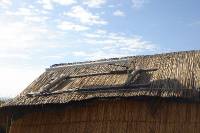Profile
Blog
Photos
Videos
We visited Uros Islands, the floating islands on Lake Titicaca. Lake Titicaca is around 175km long and 60km wide and is shared with Bolivia. They began their floating villages in order to isolate themselves from the Collas and the Incas and they have stayed on the lake ever since.
The main work nowadays for the locals is fishing and tourism. The islands are made from the Totora reeds, which are used for everything by the islanders, from the islands themselves, their buildings, boats and models to sell to tourists; they even use it to clean their teeth, as the reeds contains calcium and also to help with the menopause!
There are around 22 islands, housing around 300 families. The families have become very modern, in ways - some islands having solar powered electricity, others having computers!! During the rainy season new reeds are added to the top of the islands every week and in the dry season, twice a month. The bottom reeds rot away and so have to be added from the top. They use the roots of the reeds to keep their islands afloat.
From the islands we headed to Isla Taquile, which is an actual island in the largest part of the Lake. The island is inhabited by by Quechua people and maintain a strong group identity. There are around 2000 people on the island. Originally passenger boats were brought to the island by people from Puno, on the mainland, but the islanders decided to stop these boats, opting to provide the service themselves in order to control tourism. The main work done by the island is agriculture and handicrafts. The men do the knitting and the women spin the wool. The locals wear traditional dress, with single men wearing red and white hats and the married men wear red hats which look like a floppy nightcap! The important people wear black hats. The island is basic, having little electricity, no cars and not even any bicycles! We spent a while looking around the main square, looking at the handicrafts and a photographic exhibition where the locals were taught how to use digital cameras and the photos are really good! Then we went for a traditional lunch of Quechua soup and fish from the lake...with chips! Then it was a 2.5 hr boat journey back to the mainland.
- comments










